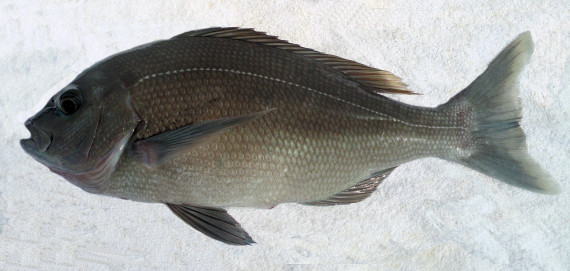Black Snapper, Apsilus dentatus
 Black Snapper, Apsilus dentatus. Fish caught from coastal waters off Puerto Aventuras, Quintana Roo, January 2016. Length 27 cm (10.5 inches). Catch and photograph courtesy of Nick Morenc, Mission Viejo, California.
Black Snapper, Apsilus dentatus. Fish caught from coastal waters off Puerto Aventuras, Quintana Roo, January 2016. Length 27 cm (10.5 inches). Catch and photograph courtesy of Nick Morenc, Mission Viejo, California.
The Black Snapper, Apsilus dentatus, is a member of the Snapper or Lutjanidae Family, that is known in Mexico as pargo lamparita. Globally, there are two species of the genus Apsilus, and only one is found in Mexican waters, this species from the Atlantic Ocean.
The Black Snapper has an elongated oval fusiform compressed body with a depth that is 38% to 42% of standard length. They are dark brown with a violet tinge and transition to lighter brown ventrally. Juveniles are blue. They have a prominent white lateral line set high on their body. They have a small head, a short pointed snout that is convex between the eyes, and a small terminal mouth. The anterior teeth on their upper jaw are canine-like. They have a row of simple teeth on both jaws, an outer row of conical teeth, and small conical teeth on the front and sides of the roof of their mouth with the tooth patch in the center being triangular or V-shaped. Their gill covers are serrated. Their anal fin has 3 spines and 8 rays; their caudal fin is lunate; their dorsal fin has 10 spines and 9 or 10 rays; and, their pectoral fins are long. They have 15 or 16 gill rakers on their first arch. They are covered with small to mid-sized scales that run parallel to the lateral line on their back.
The Black Snapper resides in and around coral reefs at depths between 9 m (30 feet) and 305 m (1,000 feet). Juveniles are found in shallower waters than adults. They are medium-sized Snappers that reach a maximum 65 cm (2 feet 2 inches) in length and 3.2 kg (7.0 lbs) in weight. As of January 1, 2024, the International Game Fish Association world record stood at 4.08 kg (9 lbs 0 oz) with the fish caught in coastal waters of the Bahamas in February 2012. They are found as solitary individuals or in small groups and feed on small fish and bottom-dwelling species including crustaceans, squid, and large zooplankton. Reproduction occurs throughout the year with the release of pelagic eggs that are fertilized externally. They eventually settle out in suitable habitat that protects them from predation. The Black Snapper is poorly studied with very limited information available about their lifestyle and behavioral patterns including specific details on age, growth, longevity, movement patterns, diet, habitat use, and reproduction.
The Black Snapper is a resident of Mexican waters of the Atlantic Ocean but is only found along the east coast of the Yucatán Peninsula in the Caribbean; they are absent from the Gulf of Mexico.
The Black Snapper is a straight forward identification that cannot be confused with any other species due to its uniform drab color, elongated body shape, and prominent lateral line.
From a conservation perspective the Black Snapper is currently considered to be of Least Concern with stable, widely distributed populations. Although fairly common in some parts of the Caribbean they are of limited interest to most. They are caught on a limited basis primarily by commercial fishermen with hand lines. They are considered a good food fish and sold occasionally fresh or frozen in local markets.